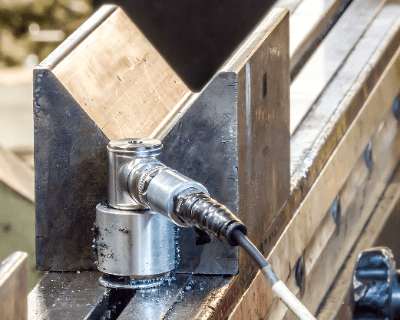What Is a Vibration Sensor?

Vibration Sensors are sensing elements used to measure the vibration state of a machine or object.
Vibration Sensors are necessary to understand and monitor the vibration state of a machine. There are three indices that represent the vibration of an object: acceleration, velocity, and displacement. Vibration Sensors measure these physical quantities and convert them into electrical quantities such as voltage and current.
In general, Vibration Sensors are available in two configurations: contact and non-contact. Depending on the physical quantity being measured (acceleration, velocity, displacement) and the conditions of the object, these two types of Vibration Sensors must be used in different ways. In addition, the magnitude and frequency range of the object being measured, as well as the measurement environment, must be taken into consideration when selecting a detailed Vibration Sensor to improve measurement accuracy.
Applications of Vibration Sensors
Vibration Sensors are used in production facilities and research and development. In production facilities, Vibration Sensors are useful for preventive maintenance to detect equipment failures and damage at an early stage. The use of sensors can prevent the occurrence of huge repair costs and loss of production efficiency due to breakdowns and damage.
In recent years, small Vibration Sensors have been used in production facilities, mostly for the purpose of machine diagnostics and predictive maintenance using IoT technology. An example of the use of Vibration Sensors in the field of research and development is the measurement of vibrations in product testing and durability testing.
Vibration Sensors are also used to evaluate passenger comfort, particularly in the automotive industry. Other applications in the field of industrial equipment range from electrical equipment and automobiles to production robots.
Principle of Vibration Sensors
As mentioned above, there are two types of Vibration Sensor configurations: contact and non-contact. Contact Vibration Sensors are used to measure acceleration, while non-contact Vibration Sensors are used to measure velocity and displacement.
This section introduces the principle of each type of Vibration Sensor suitable for various vibration (acceleration, velocity, and displacement) measurements.
1. Contact Type: Acceleration-Sensing Piezoelectric Sensors
Piezoelectric sensors utilize the piezoelectric effect that occurs in piezoelectric materials. The piezoelectric effect is a phenomenon in which a piezoelectric material (piezoelectric element), such as a single crystal of quartz, generates an electric charge on its surface when subjected to a force. The piezoelectric effect produces an electrical signal corresponding to the acceleration.
2. Non-Contact: Laser-Doppler Sensor with Velocity Detection
Laser-Doppler sensors are sensors that utilize the Doppler effect. A laser beam is emitted from the Vibration Sensor to a vibrating object, and the frequency change of the laser beam reflected from the vibrating object is converted into a voltage as a change in velocity.
3. Non-Contact Type: Displacement-Detecting Capacitive Sensor
Capacitive sensors are sensors based on the principle of measuring the capacitance between the sensor and the object to be measured and calculating the distance. When the distance between the sensor and the object to be measured changes, the capacitance value changes, thereby measuring the displacement of Vibration Sensor.
Other Information on Vibration Sensors
1. Detecting Elements of Vibration Sensors
The detection element of mechanical vibration is the temporal change in the magnitude of a quantity representing the motion or displacement of a mechanical system. In many cases, the vibration alternates between a state that is greater than or less than the average or reference value. In general, this vibration is composed of three elements: amplitude, frequency, and phase.
In particular, vibration that repeats at regular intervals is called harmonic vibration and consists of a single frequency. In such cases, displacement, velocity, and acceleration are as follows. By differentiating the displacement, the velocity can be derived, and by differentiating the velocity, the acceleration can be derived.
- Displacement d = Dsin (ωt + Φ)
- Velocity v = Vcos (ωt + Φ)
- Acceleration a = – Asin
D: single amplitude, ω: each velocity ω=2πf, f: frequency f=1/T, T: period (seconds), Φ: initial phase.
The types of Vibration Sensors used to detect this harmonic vibration include Acceleration Sensors (piezoelectric type), Velocity Sensors (electrokinetic type), and Non-contact Displacement Sensors (eddy current type). Among these, the piezoelectric type acceleration sensor in particular is characterized by its ability to cover a wide frequency range.
2. Usage of Vibration Sensors
As an example, we will explain how to use a piezoelectric Vibration Sensor, which is used for vibration monitoring. Piezoelectric Vibration Sensors utilize the piezoelectric effect, and when an external force is applied, they generate and output an electric charge proportional to that force. Piezoelectric Vibration Sensors with charge output are particularly advantageous for miniaturization.
It is important to fix the sensor firmly with stud bolts to ensure it closely adheres to the non-measured object. If the sensor is not firmly attached, it may exhibit distinctive filter characteristics with peculiar attenuation patterns in the frequency response, thus making accurate measurements impossible. Other methods include using adhesives or magnets to fix the sensor.
Frequency analysis is widely used to analyze data detected by Vibration Sensors. Frequency analysis is a method of examining the frequency components and intensity of the measured waveform, and can provide an indicator to determine whether the vibration of an object is in normal operating condition or not.